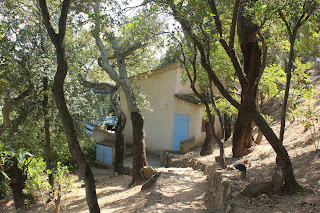A typical island configuration in a new house
In many kitchens now the island has gotten wider, and it's used for serving and socializing, not food prep. The serving side has cabinets, the socializing side is open below for chairs or stools.
So, one might ask, if the island functions like a table, why not finish it like one and put a wood counter on top?
Once you make that leap, a host of new possibilities open up, including one that's been handcrafted by a local cabinet maker. He'll make something very unusual because cabinet makers get their wood from many different sources, including local urban timber sawyers. These specialists prepare trees that are blown down in storms or cut down because they are diseased for a cabinet maker's use. A sawyer's wood will always have local cachet (it could be from a tree in your town or even your own neighborhood) and, depending on the age of the tree when it was taken down, the boards can be unusually wide.
John Haling stands next to boards that could be made into a "book matched" counter
John Haling (http://www.johnsurbantimber.com), a sawyer who works with urban timber in Whitmore Lake, Mi., said he often gets old trees that produce boards as wide as 40 inches, wide enough that a single board can be used to make a kitchen counter. Haling himself makes counters, including ones that are "book matched" (two boards from the same tree are laid next to each other so that the grain pattern of each board appears to mirror the other one) and counters with one or more "live edges" (instead of planing the edge of the board to be smooth and straight, the bark is left on and the edge is irregular).
Jeff Jenkins' butcher block counter combines local and exotic hardwood species
A cabinetmaker can fabricate a more conventional countertop with smaller pieces of wood, but the look will still be unique. For example, Jeff Jenkins (http://www.jeffreyjenkins.com), an Alexandria, Vi., cabinet and furniture designer, has made butcher block counters that combine locally sourced maple, cherry, ash and walnut with unusually colored tropical hardwoods.
Jeff Jenkins' walnut countertop made from a single piece of black walnut
Jenkins has also made single plank counters of black walnut, a species that is now so rare in the Washington area it took him two years to locate a small supply from an urban timber sawyer in Pennsylvania.
If you're ready to take an unconventional path, a handcrafted wood counter could be the beginning of an entirely handmade kitchen (wapo.st/OSN37k), with handmade tiles for backslashes and counters in food prep areas, handmade cabinet knobs and pulls and handmade cabinets.








































